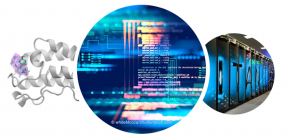
CompBioMed core partners Rutgers State University of New Jersey and University College London are working together to push the boundaries of efficiency and scalability for computational drug discovery workflows that are routinely employed in industry and academia. Their joint software project HTBAC (high throughput binding affinity calculator) combines elements of the binding affinity calculator developed at UCL’s Centre for Computational Science (led by Peter Coveney) with the RADICAL cybertools middleware suite produced and maintained by the RADICAL laboratory led by Shantenu Jha at Rutgers. HTBAC is a user-friendly Python API that enables researchers to run large campaigns of ensemble-based MD simulations to calculate accurate and reproducible binding affinities for a large number of small molecules simultaneously, thus accelerating the exploration of chemical space for faster and more efficient lead optimisation.
Adaptivity and scalability lie at the core of HTBAC framework. The aim of the simulation campaign is to discriminate between strong binders and weak binders, so the automated execution of simulations must be adaptive to ensure that the bulk of the available computational resources are directed towards the most promising candidates only. By analysing the results and performing uncertainty quantification at run-time, the code can adapt the simulation protocol by increasing the number and/or duration of simulations for the strong binders to improve the precision of their calculated binding affinities, while reducing the number of simulations executed for weaker binders and drug candidates for which the binding affinity converged relatively early on in the protocol. This allows researchers to the increase the throughput of drug candidates screened while maximising the precision and robustness of their results.
A successful implementation of the HTBAC framework has now been demonstrated with the ESMACS (enhanced sampling of molecular dynamics with approximation of continuum solvent) and TIES (thermodynamic integration with enhanced sampling) free energy protocols developed by the team at UCL. It was able to accurately reproduce the results from a study published in 2017, which used an earlier, smaller-scale version of the software (BAC) to predict the binding affinities of a set of 16 potential BDR4 inhibitors provided by associate partner GlaxoSmithKline (GSK). GSK has been working closely with the team at UCL since the start of the CompBioMed project, exploring the applicability of the recently formulated ESMACS and TIES protocols to industrial scale drug delivery projects. Both protocols have been fully integrated into HTBAC, which has demonstrated unprecedented scaling to ~33,000 cores on leadership class machines including NCSA Blue Waters and ORNL Titan while screening the sixteen GSK BDR4 inhibitors with minimal overheads. HTBAC addresses the need for scalable, efficient and fully automated high-fidelity protocols in the pharmaceutical industry, which seeks to harness the ever-increasing power of HPC to revolutionise drug design and provide a platform for patient-specific medicine.
For more information, read the following articles:
